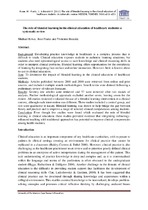| dc.contributor.author | Rowe, Michael | |
| dc.contributor.author | Frantz, Jose M. | |
| dc.contributor.author | Bozalek, Vivienne | |
| dc.date.accessioned | 2012-04-11T10:42:19Z | |
| dc.date.available | 2012-04-11T22:10:19Z | |
| dc.date.issued | 2012 | |
| dc.identifier.citation | Rowe, M., Frantz, J. & Bozalek, V. (2012). The role of blended learning in clinical education: A systematic review. Medical Teacher, 34(4):e216-e221 | en_US |
| dc.identifier.issn | 1466-187X | |
| dc.identifier.uri | http://hdl.handle.net/10566/308 | |
| dc.identifier.uri | http://informahealthcare.com/doi/pdf/10.3109/0142159X.2012.642831 | |
| dc.description.abstract | BACKGROUND: Developing practice knowledge in healthcare is a complex process that is difficult to teach. Clinical education exposes students to authentic learning situations, but students also need epistemological access to tacit knowledge and clinical reasoning skills in order to interpret clinical problems. Blended learning offers opportunities for the complexity of learning by integrating face-to-face and online interaction. However, little is known about its use in clinical education.
AIM: To determine the impact of blended learning in the clinical education of healthcare students.
METHODS: Articles published between 2000 and 2010 were retrieved from online and print sources, and included multiple search methodologies. Search terms were derived following a preliminary review of relevant literature.
RESULTS: A total of 71 articles were retrieved and 57 were removed after two rounds of analysis. Further methodological appraisals excluded another seven, leaving seven for the review. All studies reviewed evaluated the use of a blended learning intervention in a clinical context, although each intervention was different. Three studies included a control group, and two were qualitative in nature. Blended learning was shown to help bridge the gap between theory and practice and to improve a range of selected clinical competencies among students.
CCONCLUSION: Few high-quality studies were found to evaluate the role of blended learning in clinical education, and those that were found provide only rudimentary evidence that integrating technology-enhanced teaching with traditional approaches have potential to improve clinical competencies among health students. Further well-designed research into the use of blended learning in clinical education is therefore needed before we rush to adopt it. | en_US |
| dc.description.sponsorship | The authors would like to acknowledge the National Research Foundation who provided funding towards this research. | en_US |
| dc.language.iso | en | en_US |
| dc.publisher | Association for Medical Education in Europe | en_US |
| dc.rights | The file stored in the Repository is the author post-print version of an article published by Informa Healthcare (Taylor & Francis), and may be freely used, subject to acknowledgement of author. The link to the published version appears below. | |
| dc.subject | Clinical education | en_US |
| dc.subject | Blended learning | en_US |
| dc.subject | Systematic review | en_US |
| dc.subject | Healthcare | en_US |
| dc.title | The role of blended learning in clinical education: A systematic review | en_US |
| dc.type | Article | en_US |
| dc.privacy.showsubmitter | true | |
| dc.status.ispeerreviewed | true | |

